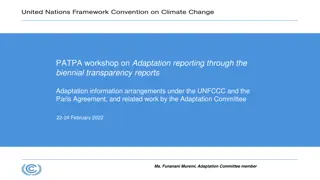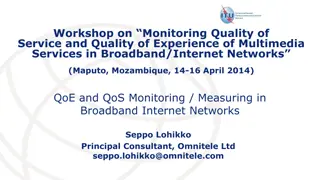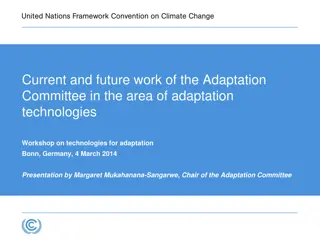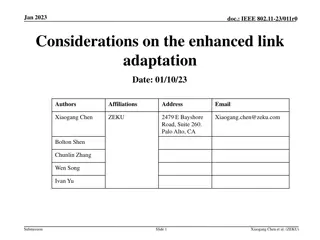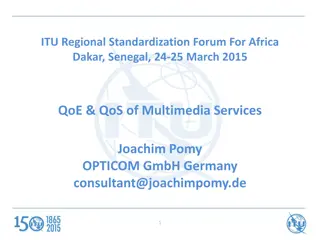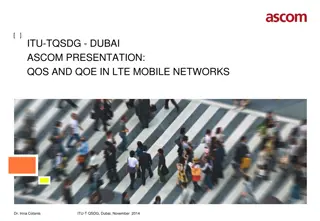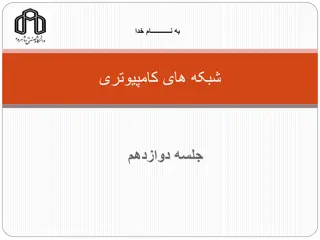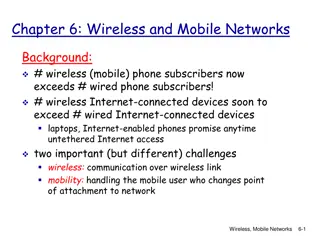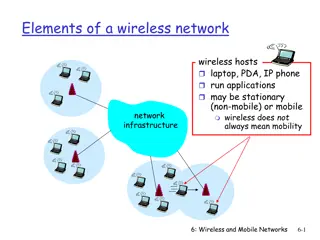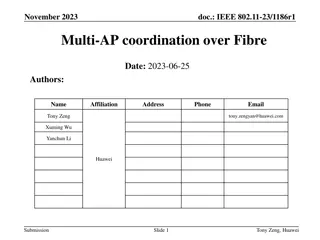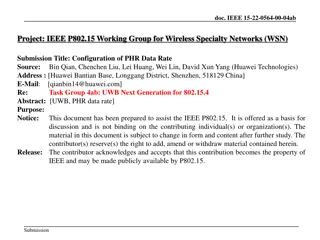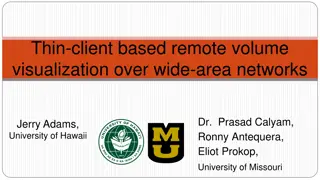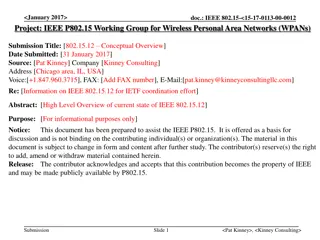QoE-Aware Video Rate Adaptation in IEEE 802.11 Wireless Networks
This research explores QoE-aware video rate adaptation algorithms in multi-user IEEE 802.11 wireless networks to provide quality of experience guarantees to wireless video customers. The study delves into centralized algorithms, resource sharing, and deep learning in wireless systems to enhance video quality and network performance.
Download Presentation

Please find below an Image/Link to download the presentation.
The content on the website is provided AS IS for your information and personal use only. It may not be sold, licensed, or shared on other websites without obtaining consent from the author.If you encounter any issues during the download, it is possible that the publisher has removed the file from their server.
You are allowed to download the files provided on this website for personal or commercial use, subject to the condition that they are used lawfully. All files are the property of their respective owners.
The content on the website is provided AS IS for your information and personal use only. It may not be sold, licensed, or shared on other websites without obtaining consent from the author.
E N D
Presentation Transcript
QoE-aware Video Rate Adaptation algorithms in multi-user IEEE 802.11 wireless networks Federico Chiariotti Chiara Pielli Andrea Zanella Michele Zorzi Contact: zanella@dei.unipd.it ICC2015 - London 1
Multimedia traffic growth source: Cisco report (2014) 2
Goal Provide Quality of Experience (QoE) guarantees to wireless video customers Video server video user 1 Wireless Access Point video user 2 Video video user 3 user n 3
State of the art* Plenty of Call Admission (CA) control and Video Rate Adaptation (VRA) algorithms in the literature Many [6-9] are QoS-based do not consider QoE Others [11-15] consider user-centric distributed solutions may not achieve overall optimal utilization of wireless resources 4 * See Bibliography in paper
Our starting point In our recent works we showed that: [16] Different videos with equal rate have different quality (which can be measured in terms of SSIM) [17] The rate/distortion characteristic of a video can be estimated using a deep learning approach [18] Resource sharing based on per-video rate/distortion characteristics achieves higher performance than QoS-based approaches (over wired connections) 5
In this work we propose QoE-aware CA&VRA for wireless systems, which are Centralized Algorithms are run at the wireless access point (AP) Based on rate/distortion characteristics Minimum QoE is guaranteed to each admitted clients 6
Settings and notation 3 second long chunks rate/distortion curves Increase compression Quality (q) Increase compression Video source Rate (R)
VRA constraints Quality above threshold (qthr) Quality of video required by user i at compression level j Quality threshold for user i qi,j>qthr Network stability Number of users Source rate of video required by user i at compression level j stability margin Fraction of resources taken by user i User i throughput 8
Quality-Based algorithm (QB) qthr 3 2 1 1 9
Quality-Based algorithm (QB) qthr 3 2 1 OK! 1 New video is accepted New encoding of active videos are enforced 10
Quality-Based algorithm (QB) qthr 2 3 1 1 BLOCK! New video is NOT accepted Current encoding of active videos is maintained 11
Time-Based algorithm (TB) qthr All above threshold ok 2=1/3 1=1/3 3=1/3 New video is accepted New encoding of active videos are enforced 12
Benchmark algorithm (BM) Clients autonomously adapt to network conditions according with average application-layer performance if the time needed to receive M frames increases above threshold increase compression level If it drops below another threshold (for a few consecutive frames) decrease compression level 13
Versions of the algorithms Clients are divided in three classes, based on SNR Gold Silver Bronze VRA algorithms can be S: Single-class same qthrfor all clients C: Class-based qthrdepends on class 14
Scenario IEEE 802.11g N=15 clients uniformly distributed over the WiFi cell Random video requests (Poisson process) 15
Average SSIM 17
Conclusions Class-based versions achieve more uniform (and lower) blocking probabilities, but they pay a price in terms of average SSIM TB is the most efficient algorithm, blocking fewer requests and maintaining a higher average quality further research can improve the algorithms (foresight, mobility support) 19
QoE-aware Video Rate Adaptation algorithms in multi-user IEEE 802.11 wireless networks Any questions? 20 Contact: zanella@dei.unipd.it
Simulation setup video duration based on traces average offered load of ~10 videos QoE for each class: Minimum SSIM Approximate target MOS Class SNR Gold 0.99 dB 5 Silver 0.98 12.35 20dB 4.5 Bronze 0.96 < 12.35dB 4 21
Simulation setup average offered application layer traffic: 10MBps and 20Mpbs 10 simulations of 5000s each for both traffic intensities random clients distribution within circular area with radius of 150m 22
Quality-Based algorithm (QB) Start from full quality Increase compression of videos with larger margin from qthr No Stable? Yes Accept new videos & adjust rate of all active videos No Yes Block new video qi>qthr? 23
Time-Based algorithm (TB) Equally split bandwidth among all videos Redistribute excess bandwidth Bandwidth enough for video i? Yes Start from full quality No Increase compression of video i Accept new videos & adjust rate of all active videos Yes qi>qthr? No Block new video 24



